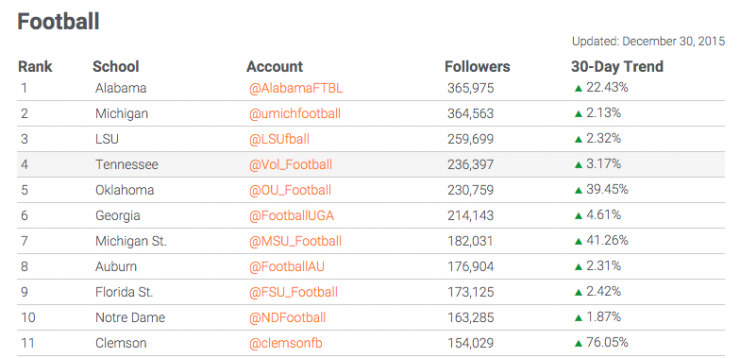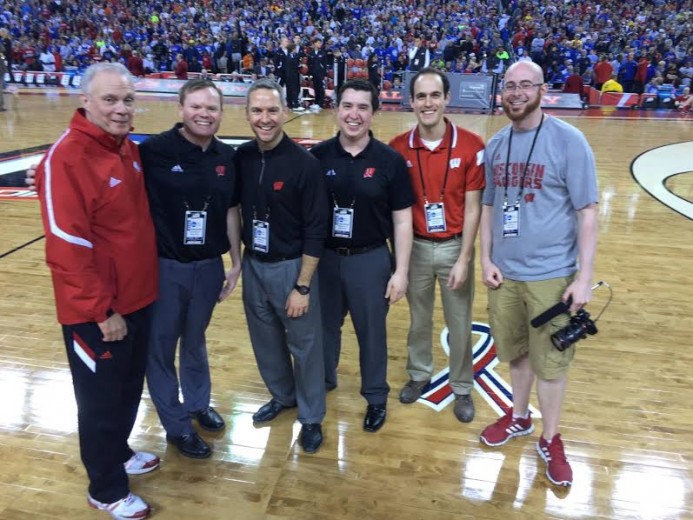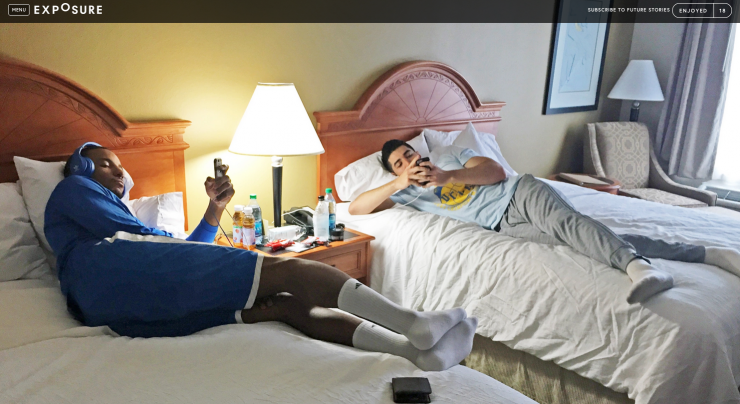This year’s College Football National Championship was an instant classic. With back and forth leads, big plays and the beloved pylon cam, it was everything you could want from the National Championship game.
And like every other major sporting event, the social media + sports community tuned in to TVs, screens and everything eles to watch the coverage unfold. Early on it was easy to see the contrast different in the approach to both Clemson and Alabama’s coverage
@WarJessEagle The major difference between the two teams approach to social. Clemson with more graphics and visuals. Alabama more just PxP.
— Jason Brower (@JaBrow) January 12, 2016
@WarJessEagle Stark contrast amongst Bama and Clemson's social presence. Each was used appropriately for each school's strategy.
— Tariq Ahmad (@tariq_ahmad) January 12, 2016
@WarJessEagle Two very different social media styles that mirrors programs. Clemson louder, used more graphics/GIFs. Bama more traditional.
— Michael Murakami (@MichaelMurakami) January 12, 2016
There are a lot of great lessons, ideas and tidbits to take away from the coverage. Below are some highlights, with a little help from my #smsports friends:
CLEMSON
Clemson might not have taken home the hardware that night, but they definitely won the social media and sports game. Equipped with a team ready to turn out quality content with speed, Clemson’s coverage of the game truly enhanced the viewing experience. Their focus was on a rich media experience, telling the story of the game through photos, videos, Vines, etc. Here are a few of the things that stood out about Clemson’s coverage below.
Repurpose stories.
Early in the season Clemson released a beautiful video called “The Dream”. Given the theme, it was almost as if they predicted the season they were going to have. Their team spliced, diced and shared this video and theme multiple ways throughout the year:
Clemson carried “The Dream” thematic with them to the National Championship, pushing out the original content again and also creating new content inline with the video. Here’s a look at a few pieces:
All too often we create good content, push it out once and walk away. Good content and good stories require building. Good content requires thoughtful and creative distribution if you want it to be seen. Not matter how good the piece is, you can’t expect to share it once and reach the audience it deserves. If you spend time developing a great story, make sure you spend the time thinking through how you can distribute it throughout the year and extend the story with additional content. Repurpose, retell and redistribute.
Timing is everything.
During games, timing is everything with social media coverage. Clemson has the manpower to act swiftly and nimbly, and it shined in their coverage. Content was pushed out quickly and always at the right moment. The best example of this is their tweet right after Alabama scored their first TD:
Dabo: “There will be adversity. When it comes, you stick together and do what we do.” #ALLIN pic.twitter.com/wtnkz2N88j
— Clemson Football (@ClemsonFB) January 12, 2016
This was the perfect sentiment at the perfect moment. Instead of letting negativity find fans, the Clemson social team swooped in with an emotional piece of content to set the tone.
When planning for a national stage like this, it’s a good idea to have a bank of strong content you can pull for different scenarios. If you get the content generic enough, you can use copy to pull it into the scenario. Remember, you can plan for the unexpected in sports. You just have to get a little creative.
Capitalize on the moment.
When your team is on a championship stage, it’s an opportunity to get in front of a whole new audience. Capitalize on the moment to spread a larger message on what your school, team, traditions, etc. are all about.
@WarJessEagle I really liked how the @ClemsonFB account capitalized on spotlight and intentionally promote university throughout the week.
— Morgan Strehlow (@morganstrehlow) January 12, 2016
Clemson didn’t focus only on the championship game that week; they also took it as an opportunity to shine a wider light on their university and academics.
? What a time to be a Tiger! ? Just being introduced to Clemson? Learn more here: https://t.co/bTsHBjfhq1 pic.twitter.com/qCT0qhAtY1
— Clemson Football (@ClemsonFB) January 12, 2016
When you’re on a big stage—whatever it is—use the opportunity to tell a broader story far beyond the game. Whether it’s highlighting emotional stories on the team, showcasing academics, tapping into tradition, etc., you should absolutely capitalize on your moment in the spotlight.
Diverse portfolio of content.
This season Clemson did a fantastic job of telling their story through a variety of content. They always mix it up, from Vines to GIFS to photos, and it is anything but dry. In fact, their content is normally composed of one of two things: Emotion or swagger. From their touchdown GIFS to their video storytelling, here’s a look at some their content highlights from the night:
TOUCHDOWN!!!! Tay Scott takes on into the endzone, the Tigers make it look easy. Not. Done. Yet. #ALLIN pic.twitter.com/4cWzMsg5Rk
— Clemson Football (@ClemsonFB) January 12, 2016
Just 15 minutes remain… #ALLIN pic.twitter.com/XpGN65paZz
— Clemson Football (@ClemsonFB) January 12, 2016
What a time to be a Tiger! Win or lose, we’ll love these boys just the same! They make the #ClemsonFamily PROUD! pic.twitter.com/B1QqohzbN4
— Clemson Football (@ClemsonFB) January 12, 2016
Dabo: "Embrace this moment. Cut it loose. Let that light shine through." #ALLIN pic.twitter.com/k7Xe3N1PtC
— Clemson Football (@ClemsonFB) January 12, 2016
"There is POWER in the Paw…" #ALLIN pic.twitter.com/ePy0IzieyQ
— Clemson Football (@ClemsonFB) January 12, 2016
Content that is diverse and unpredictable makes it fun to follow along. It’s also more likely to standout from all the noise.
Thoughtful approach to a loss.
Clemson handled their loss better, and with more emotion, than a team I’ve seen in recent memory. They didn’t shy away from their content. Instead, they embraced the emotional journey of the loss, of their year, of their team.
Clemson found a way to tell a graceful and emotional story after the game. The content was extremely creative too, from paying attention to the stains earned to a recollection of a few of the players on their National Signing Day.
@WarJessEagle @ClemsonFB's very classy, shareable postgame tweet. Executed perfectly w/ higher degree of difficulty. pic.twitter.com/KAZ9tpkfgA
— Zack Waldman (@ZackWaldman) January 12, 2016
This didn’t happen overnight… And a loss doesn’t mean it’s over. See you next season. #ALLIN https://t.co/oMQ8x2KtlT
— Clemson Football (@ClemsonFB) January 12, 2016
The stains will wash away… The cuts will heal… But the memories will remain. #ALLIN ?? #Clemson https://t.co/k2RWNOhTj9
— Clemson Football (@ClemsonFB) January 17, 2016
“Lights will guide you home…” #ClemsonFamily https://t.co/SYmj2WDMOo
— Clemson Football (@ClemsonFB) January 14, 2016
This is what's waiting on us when we get back to Clemson… #ALLIN pic.twitter.com/QpJ8ZWivPt
— Clemson Football (@ClemsonFB) January 13, 2016
"The best is yet to come." #ClemsonFamily #ALLIN pic.twitter.com/M5zP3J5SaC
— Clemson Football (@ClemsonFB) January 12, 2016
A loss doesn’t mean you have to hang your head and be silent, especially after the year that Clemson had. Clemson proved you can tap into the emotion of a heartbreaking loss and come out stronger. Every loss and situation is different, but for their situation, Clemson couldn’t have handled the loss any better.
A few other highlights from Clemson that stood out to the #smsports crew:
@WarJessEagle (1/2) I felt @ClemsonTigers truly embodied not only storytelling, but story living before, during, and after the game.
— Karen Freberg, Ph.D. (@kfreberg) January 12, 2016
@WarJessEagle Clemson clearly had multiple content producers on-site, but voice/style remained consistent. Very impressive (and difficult).
— Eric Wieberg (@ewieberg) January 12, 2016
@WarJessEagle Clemson's posting speed was ridiculous. True second screen experienced. Direct to SM for BHS action, tying into broadcast
— Rhodri Williams (@TheRealRhodri) January 12, 2016
ALABAMA
Alabama’s coverage of the National Championship game was vastly different than Clemson. They took a more traditional approach on Twitter, focusing on stats and play-by-play. At the end of the game they turned to more rich content—native video, photos and graphics.
@WarJessEagle I liked Bama's simplicity and the "we'll let the play do the talking" approach was refreshing in contrast to Clemson.
— Dom Lewis (@DommyDigital1) January 12, 2016
When you’re on a national stage like the championship though, I believe content deserves to be stepped up a notch. As talked about earlier, there are more eyes on your program than ever before. While the dry play-by-play might have been Alabama’s strategy, it would have been nice to see a little more emotion, depth and storytelling. After all, it’s a storied program (and as an Auburn fan, that hurts to say).
Even then, Alabama owned their strategy through and through and it was wildly differently that Clemson’s—maybe that was the point. Below are a few other key highlights.
Graphics game on point.
The graphics Alabama turned out throughout the game were sharp and easy to consume. Their design game has always been strong; in fact, I wish we got to see more of it.
#RollTide it's Game Day! @AlabamaFTBL plays Clemson tonight for the #NationalChampionship pic.twitter.com/XX2bmVNxZu
— Alabama Athletics (@UA_Athletics) January 11, 2016
Roll Tide Roll! @AlabamaFTBL YOUR 2015 National Champions! #RollTide #NationalChampionship #Sweet16 pic.twitter.com/AWhJFOqNDu
— Alabama Athletics (@UA_Athletics) January 12, 2016
.@AlabamaFTBL, winners of the #NationalChampionship game #RollTide pic.twitter.com/PCUQBIIQAh
— Alabama Football (@AlabamaFTBL) January 12, 2016
Native video.
While a lot of Alabama’s game coverage was dry, they did do a good job of utilizing native video on Facebook and Twitter.
.@AlabamaFTBL is in the house #NationalChampionship #RollTide pic.twitter.com/jCOiBsy6sE
— Alabama Football (@AlabamaFTBL) January 11, 2016
Are you ready to #RollTide? #NationalChampionship pic.twitter.com/jkK1U01KJQ
— Alabama Football (@AlabamaFTBL) January 12, 2016
Video tells a more impactful story than photos and text alone. And, video consumption continues to grow. Video doesn’t have to be long or edited for it to perform well either, as the content above shows. Take the time to integrate video into your plan.
OTHER HIGHLIGHTS
Below are some other highlights from #smsports friends and/or content that stood out:
@WarJessEagle @CollegeGameDay Vine's were incredible – real time AND unique POV; stood out amongst a lot of noise https://t.co/Yy3XAexZLF
— Josh Lukin (@coffeeon3rd) January 12, 2016
@WarJessEagle really liked this one https://t.co/eALCw8adwi
— Ignacio Cassinelli (@igncass) January 12, 2016
@WarJessEagle Instagram partners with ESPN on new live feed. Robust mix of game footage and UGC.
— Nick Marquez (@Quezzymoto) January 12, 2016
Congratulations buddy @Official_Big_Al pic.twitter.com/tDxIKS6Yit
— The Oregon Duck (@TheOregonDuck) January 12, 2016
Nailed it. pic.twitter.com/WR0nabiE95
— College GameDay (@CollegeGameDay) January 12, 2016
Real recognize real. (via @SECNetwork) https://t.co/ymccomZUwo
— College GameDay (@CollegeGameDay) January 12, 2016
Sorry. https://t.co/Oi3oTwGLk9
— SEC Sports (@SEC) January 12, 2016
The next college football game is Thursday, September 1. Stay strong, everyone.
— SEC Sports (@SEC) January 12, 2016
I would love your thoughts. What stood out to you? Share below!
Thanks for reading!





